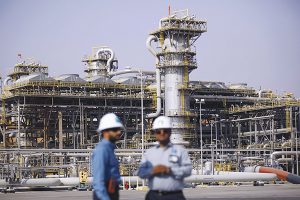Bloomberg
The Opec+ alliance decided to maintain production at current levels, pausing to take stock of a global oil market that’s roiled by uncertainty over Chinese demand and Russian supply.
The outcome of the brief online meeting on Sunday reflects the unpredictability of supply and demand in the coming months, and the wild gyrations in prices of the past week.
The oil producers’ group has only just implemented the hefty 2 million barrel-a-day reduction agreed at its last gathering. Meanwhile, European Union sanctions on crude exports from Russia come into effect on Monday, and China is tentatively easing the Covid measures that have eroded its fuel consumption.
Brent crude falls to lowest level since September on November 28, but ended up posting its biggest weekly gain in a month.
The decision by the Organisation of Petroleum Exporting Countries and its allies should hold for at least a few months. The group’s Joint Ministerial Monitoring Committee, led by Saudi Arabia and Russia, will meet again in February. The outlook could be clearer by then, and the panel has the power to call extraordinary meetings if it thinks output policy may need to change. The oil market could look quite different by early 2023, with several potentially historic shifts in supply and demand unfolding in the coming days and weeks.
As Opec+ ministers convened their video conference, officials in Shanghai had just eased some of their Covid-19 restrictions, joining other top-tier Chinese cities as authorities accelerate a shift toward reopening the economy after thousands of demonstrators took to the streets.
Top government officials over the past week have signalled a transition away from the harshest containment measures, which have weighed on the economy in the world’s largest oil importer.
On Monday, the EU will ban most seaborne imports of Russian crude and block anyone else from using the region’s shipping or insurance services for purchases of Russian oil, unless it’s done so below a $60-a-barrel price cap.
It’s unclear to what extent those measures will curtail Russian exports. The price cap is comfortably above the $50 that the country’s flagship Urals grade of crude currently trades at, according to data from Argus Media.
The cut “was purely driven by market considerations, and recognised in retrospect by the market participants to have been the necessary and the right course of action towards stabilising global oil markets,†Opec said.
 The Gulf Time Newspaper One of the finest business newspapers in the UAE brought to you by our professional writers and editors.
The Gulf Time Newspaper One of the finest business newspapers in the UAE brought to you by our professional writers and editors.
